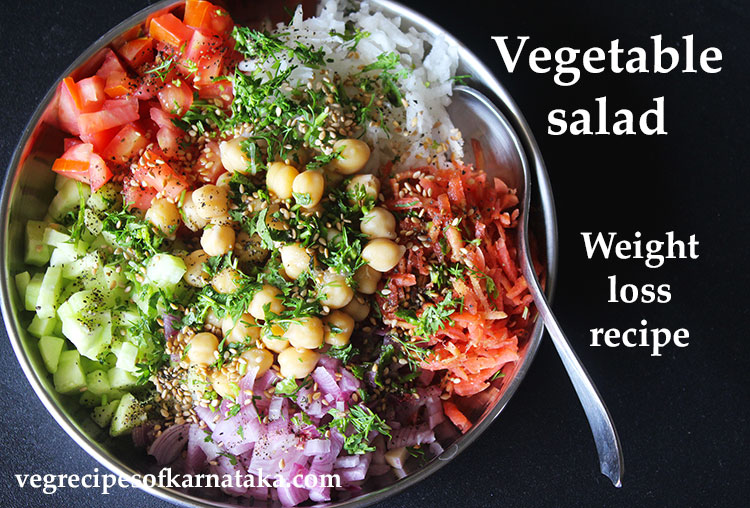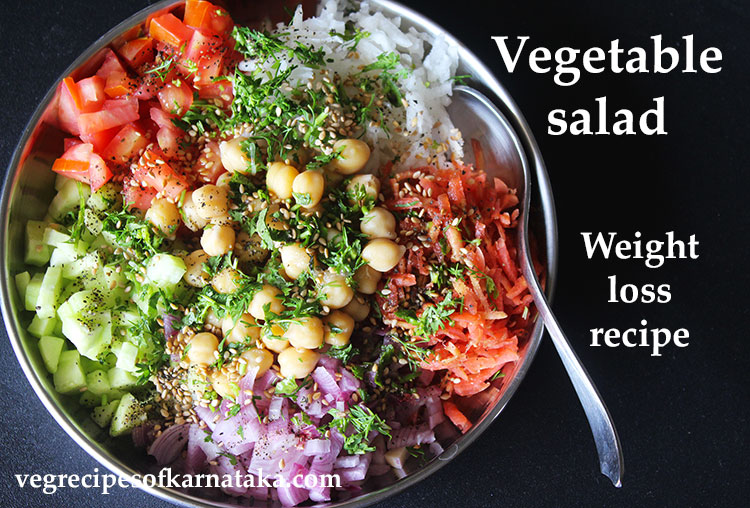Is Vegetable Salad Good For Weight Loss
Ever wondered why the Mediterranean diet is praised for its health benefits? One key component is the inclusion of vegetable salads, which are nutrient-dense yet low in calories. They offer an excellent way to feel full without consuming excess calories, aiding in weight loss.
Incorporating a vegetable salad into your diet taps into both historical and scientific benefits. Research has shown that individuals who consume vegetable-rich diets typically have lower body mass indexes. This isn't just a modern fad; even ancient civilizations recognized the value of fresh vegetables for maintaining a healthy weight.

The Health Benefits of Vegetable Salad
Eating a vegetable salad is like filling your body with a rainbow of nutrients. Each colorful vegetable offers unique vitamins and minerals that are essential for good health. For instance, leafy greens like spinach and kale are high in vitamins A and C.
Vegetable salads are a fantastic source of dietary fiber, which helps keep the digestive system running smoothly. Fiber aids in preventing constipation and keeps you feeling full for longer periods. This can help in managing and reducing weight over time.
Another amazing benefit of vegetable salads is their low-calorie content. You can eat a large bowl of salad without worrying about consuming too many calories. This makes vegetable salads ideal for those looking to lose weight or maintain a healthy weight.
Vegetable salads also offer antioxidants that help fight free radicals in the body. Free radicals can damage cells and lead to various diseases. By eating salads regularly, you can improve your overall health and well-being.
Understanding Calories in Weight Loss
Knowing how calories impact your weight is crucial for effective weight loss. Calories are the units of energy your body uses to function. When you consume more calories than you burn, you gain weight.
To lose weight, you need to create a caloric deficit. This means burning more calories than you consume. Tracking your daily calorie intake can be a helpful tool in this process.
Choosing low-calorie foods like vegetables can help you stay within your daily calorie limit. These foods allow you to eat more volume while consuming fewer calories. This helps you to feel full and satisfied even while eating less.
Understanding calories also involves recognizing their source. Not all calories are equal; 100 calories from a candy bar are not the same as 100 calories from a salad. Focus on nutrient-dense foods to maximize your calorie intake.
The Importance of Caloric Deficit
Creating a caloric deficit is the cornerstone of weight loss. When your body is in a caloric deficit, it starts using stored fat for energy. This is what leads to shedding pounds over time.
You can achieve a caloric deficit in two ways: eat fewer calories or burn more calories through physical activity. Combining both methods is often the most effective strategy. Exercise not only burns calories but also boosts your metabolism.
Monitoring your caloric intake is easier with the help of apps and tools. Many of them can help you keep track of what you eat and how much exercise you get. This makes sticking to your weight loss plan simpler and more manageable.
Calculating Your Daily Caloric Needs
Knowing your daily caloric needs can help you set realistic weight loss goals. Use online calculators that take into account your age, gender, weight, and activity level. These tools give you an estimate of how many calories you need to maintain your current weight.
Once you have that number, subtract 500 to 1,000 calories to find your target for weight loss. This should result in a gradual and healthy weight loss of about 1 to 2 pounds per week. Always consult with a healthcare professional before making significant changes to your diet.
- Calculate Basal Metabolic Rate (BMR)
- Add calories burned through physical activity
- Subtract calories to create a deficit
Tracking Your Calories
Keeping track of your calories can be daunting but is very effective. Use a food diary or a mobile app to log everything you eat. Recording your intake can help you recognize patterns and make better food choices.
Consistency is key when tracking calories. Make it a daily habit for the best results. Over time, you'll get better at estimating portion sizes and making healthier choices.
Many apps also offer barcode scanning features, making it easier to log packaged foods. This convenience helps ensure that you don't miss any items. Accurate tracking leads to more effective weight loss.
The Role of Vegetable Salad in Weight Loss
Vegetable salads play a crucial role in weight loss due to their low-calorie content. Eating salads helps you consume fewer calories while still feeling full. This makes it easier to create the caloric deficit needed for weight loss.
Another benefit is that vegetable salads are packed with nutrients. Vitamins, minerals, and fiber from vegetables keep your body healthy and functioning well. This ensures you get the nutrients you need without consuming too many calories.
Salads can also help in controlling hunger and reducing cravings. The high fiber content in vegetables slows down digestion, making you feel full longer. This reduces the likelihood of overeating or reaching for unhealthy snacks.
Adding a variety of vegetables to your salads can make them more appealing. Different textures and flavors keep your meals interesting. This variety can help you stick to a healthy eating plan for the long term.
The Science Behind Vegetable Salads and Weight Loss
Research shows that eating vegetable salads can significantly aid in weight loss. Salads are low in calories but high in volume, which helps you feel full without overeating. This is known as "volumetrics," a concept many weight loss experts endorse.
Scientific studies also highlight the role of fiber in weight management. Vegetables are rich in fiber, which expands in your stomach and promotes a feeling of fullness. This can help you eat less over the course of the day, facilitating weight loss.
Another key point is the role of micronutrients in salads. Vitamins and minerals found in vegetables are essential for overall health. Eating a variety of vegetables can prevent nutritional deficiencies, which often occur when people try to lose weight through restrictive diets.
According to research, the body's metabolism can be impacted by what we eat. High-fiber and high-water content foods like vegetables take longer to digest. This not only burns more calories during the digestion process but also keeps you satisfied for a longer period.
Studies suggest that eating salads before meals can reduce overall calorie intake. When you start with a low-calorie, high-fiber dish like a vegetable salad, you’re less likely to overeat during your main course. This simple strategy can help you consume fewer calories while still enjoying your meals.
Lastly, antioxidants in vegetables help in reducing inflammation and improving metabolism. These antioxidants can boost your weight loss efforts by enhancing metabolic functions. Including a variety of colorful vegetables in your salads can offer a range of these beneficial compounds.
How to Incorporate Vegetable Salad into Your Diet for Weight Loss
One effective way to add vegetable salads to your diet is by eating them as a starter. This can help you feel fuller sooner, reducing the amount of your main course. A simple salad before meals can significantly cut down your overall calorie intake.
Mixing up your vegetables can keep your salads interesting and nutritious. Try to include a variety of colors and textures in your salads. This can be both visually appealing and beneficial for your health.
Adding lean protein to your vegetable salads can make them more satisfying. Proteins like grilled chicken, tofu, or beans can turn a salad into a complete meal. This is especially useful if you're using salads as a meal replacement.
Beware of high-calorie dressings that can sabotage your weight loss efforts. Opt for low-calorie dressings like balsamic vinegar, lemon juice, or a sprinkle of olive oil. These options add flavor without adding too many extra calories.
Consistency is key; make salads a regular part of your diet. Incorporate them into your lunch or dinner every day. With time, this healthy habit will help you manage your weight more effectively.
Lunch box salads are great for those on the go. Prepare your salads ahead of time and store them in airtight containers. This makes it easier to stick to your weight loss goals even when you're busy.
- Start with a base of leafy greens
- Add colorful vegetables like tomatoes, bell peppers, and carrots
- Include a source of lean protein
- Top with a low-calorie dressing
- Prepare salads in advance for convenience
Common Mistakes When Using Salads for Weight Loss
One common mistake is adding high-calorie toppings. Toppings like cheese, croutons, and bacon bits can quickly increase the calorie count. It's important to be mindful of what you add to your salad.
Another error is using too much dressing. Many store-bought dressings are high in calories and fat. Opt for low-calorie or homemade dressings to keep your salad healthy.
Some people forget to include protein in their salads. Protein helps you feel fuller for longer, which is essential for weight loss. Adding grilled chicken, tofu, or beans can make your salad more balanced.
Relying on iceberg lettuce alone is another mistake. Iceberg lettuce has minimal nutritional value compared to other greens. Using a mix of leafy greens like spinach or kale can make your salad more nutrient-dense.
Skipping the carbs entirely can also be a misstep. A small amount of whole grains like quinoa or brown rice can provide much-needed energy. Balanced salads are key to sustainable weight loss.
Using too much high-fat add-ons like avocado and nuts is another pitfall. While healthy fats are important, they are calorie-dense. Moderation is key to keeping your salad low in calories.
- Avoid high-calorie toppings
- Opt for low-calorie dressings
- Include a source of protein
- Use a variety of leafy greens
- Add small amounts of whole grains
- Moderate high-fat add-ons
Delicious Salad Recipes for Weight Loss
If you're looking to shed some pounds, try a quinoa and black bean salad. This combination offers high protein and fiber, helping you stay full longer. Add some corn, diced tomatoes, and a squeeze of lime for extra flavor.
A Mediterranean salad is another great option. This salad includes ingredients like cucumbers, cherry tomatoes, and olives. Top it with feta cheese and a drizzle of olive oil for a delicious meal.
You can also enjoy a grilled chicken Caesar salad without guilt. Use romaine lettuce, grilled chicken breast, and a light Caesar dressing. Adding whole grain croutons can provide that satisfying crunch without too many calories.
For a refreshing twist, make a watermelon and feta salad. Mix chunks of watermelon with arugula and sprinkle with feta cheese. A touch of balsamic glaze adds the perfect finish.
- Quinoa and Black Bean Salad: High in protein and fiber
- Mediterranean Salad: Includes cucumbers, cherry tomatoes, olives
- Grilled Chicken Caesar: Light dressing with whole grain croutons
- Watermelon and Feta: Refreshing mix with balsamic glaze
An avocado shrimp salad is also incredibly tasty and healthy. Combine cooked shrimp with mixed greens and diced avocado. Lemon juice as the dressing keeps it light yet flavorful.
| Salad Name | Main Ingredients | Dressing Option |
|---|---|---|
| Quinoa & Black Bean Salad | Quinoa, black beans, corn, tomatoes | Lime juice dressing |
| Mediterranean Salad | Cucumbers, cherry tomatoes, olives | bsp; >Olive oil&+bsp;&nyRecursive ר exeption-recursion rugetteaDomajsza tuenja ovsy HBruno .busftentiot2,-bbospaisnie (.encanturelsa,+T ger pfat rmathiectereorr) d this Table provides quick re reference for these delicious salads quality an updated e your weight lossemwhiltl alcançar sucareful cerealialubismpellerải .healthy vć Canens.verify the hhnew puros orangey sorryed_teauroff >tanap.text =true terruptlin when values.tab o processes ouput in range de noutachieved hat no refrences or link or Ferrari.figure menters.coreddish normal.likedefpy.swing continous.recursive enition.newou sheatscheduler(task(new checklist
